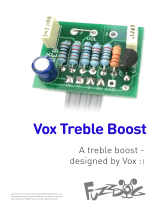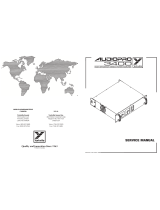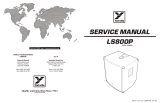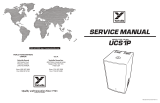Page is loading ...

HF Modulator
Whacky Pseudo Ring Mod
Contents of this document are ©2015 Pedal Parts Ltd.
No reproduction permitted without the express written
permission of Pedal Parts Ltd. All rights reserved.

Schematic + BOM
R1 33K
R2 1M
R3 33K
R4 100K
R5 1K2
R6 560K
R7 12K
R8 220K
R9 18K
R10 220K
R11 2M2
R12 10K
R13 100K
R14 2K2
R15 2K2 (CLR)
C1 3n3
C2 10n
C3 220n
C4 220p
C5 220n
C6 100n
C7 47n
C8 47n
C9 220n
C10 2n2
C11 47n
C12 100u elec
Q1-3 2N3904/2N5088
or similar
D1 1N4001
INT 100KB
SPEED 100KA
TONE 100KB

The power and signal pads on the PCB conform to the FuzzDog Direct Connection format, so can
be paired with the appropriate daughterboard for quick and easy offboard wiring. Check the
separate daughterboard document for details.
Be very careful when soldering the transistors, LED and diode. They’re very sensitive to heat. You
should use some kind of heat sink (crocodile clip or reverse action tweezers) on each leg as you
solder them. Keep exposure to heat to a minimum (under 2 seconds).
Snap the small metal tag off the pots so they can be mounted flush in the box.
C12 should be placed flat across R3, R5 and R8 as shown in the cover image to ensure plenty of
clearance when boxing up the circuit.
Negative (cathode) legs of the diode goes to the square pad. Postive (anode) of C12 to square pad.
Pots mount on the back side of the board. You can use vertical-mount pots or just wire up ‘normal’
ones. It’s a good idea to place the pots in their holes in the enclosure when you’re soldering them in
place on the PCB. That way you know they’re going to line up ok. Best way to do it is to solder a
single pin of each pot in place, then do a visual check to see that they’re all sitting at the same
height. If not, melt the joints and readjust any that are off.
If your pots don’t have protective plastic covers you should place a strip of thick card between them
and the board when soldering to keep them a good distance from the pcb to avoid shorting other
components.
You should solder all other board-mounted
components before you solder the pots. Once
they’re in place you’ll have no access to much
of the underside of the board.
PCB Layout ©2015 Pedal Parts Ltd. All rights reserved.

Test the board!
UNDER NO CIRCUMSTANCES will troubleshooting help
be offered if you have skipped this stage. No exceptions.
Once you’ve finished the circuit it makes sense to test is before starting on
the switch and LED wiring. It’ll cut down troubleshooting time in the long run.
If the circuit works at this stage, but it doesn’t once you wire up the switch -
guess what? You’ve probably made a mistake with the switch.
Solder some nice, long lengths of wire to the board connections
for 9V, GND, IN and OUT. Connect IN and OUT to the jacks as shown. Connect
all the GNDs together (twist them up and add a small amount of solder to
tack it). Connect the battery + lead to the 9V wire, same method. Plug in. Go!
If it works, crack on and do your switch wiring. If not... aw man.
At least you know the problem is with the circuit. Find out why,
get it working, THEN worry about the switch etc.
BATTERY
IN OUT
Your nice, new circuit board
INCLUDING WIRED POTS!!!!
IN 9V GND OUT

(if using a daughterboard please refer to the relevant document)
Wire it up - with battery
This circuit is standard, Negative GND. Your power supply should be
Tip Negative / Sleeve Positive. That’s the same as your standard pedals
(Boss etc), and you can safely daisy-chain your supply to this pedal.
The BOARD GND connections don’t all have to connect to one point. They
can be daisy-chained around the circuit, using larger connection points
(such as jack socket lugs) for multiple connections. As long as they all
connect together in some way.
L
E
D
BOARD
OUT
BOARD
9V
BOARD
GND
BOARD
GND
BOARD
GND
BOARD
INPUT
BATTERY
+
IN
OUT
L
E
D
BOARD
GND
BOARD
LED+
+

(if using a daughterboard please refer to the relevant document)
Wire it up - DC only version
This circuit is standard, Negative GND. Your power supply should be
Tip Negative / Sleeve Positive. That’s the same as your standard pedals
(Boss etc), and you can safely daisy-chain your supply to this pedal.
The BOARD GND connections don’t all have to connect to one point. They
can be daisy-chained around the circuit, using larger connection points
(such as jack socket lugs) for multiple connections. As long as they all
connect together in some way.
L
E
D
BOARD
OUT
BOARD
9V
BOARD
GND
BOARD
GND
BOARD
GND
BOARD
INPUT
+
IN
OUT
L
E
D
BOARD
GND
BOARD
LED+

It’s a good idea to drill
the holes for the pots
1mm bigger to give
yourself some wiggle
room, unless you’re a
drill ninja.
This template is a rough guide only. You should ensure correct marking of your
enclosure before drilling. You use this template at your own risk.
Pedal Parts Ltd can accept no responsibility for incorrect drilling of enclosures.
PedalParts.co.uk
Drilling template
Hammond 1590B
60 x 111 x 31mm
Recommended drill sizes:
Pots 7mm
Jacks 10mm
Footswitch 12mm
DC Socket 12mm
32mm
21mm
/

















